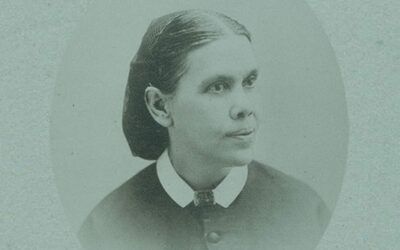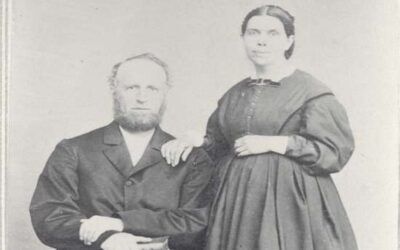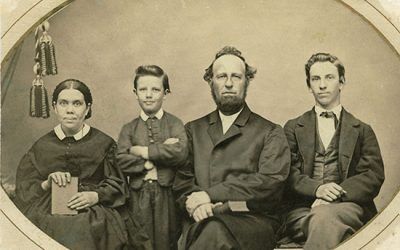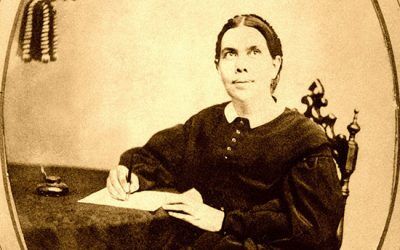When it comes to lifelong struggles with health, Ellen White was no stranger. In fact, health challenges set the tone for her life early on—years before she was involved in co-founding the Seventh-day Adventist Church.
She was born healthy in 1827 into a family of eight children. But an accident in her early years changed everything.
For most of her life, she had to cope with pain, illness, and discouragement. But she also learned to put complete trust in God, which opened the doors to amazing opportunities. God used Ellen White in extraordinary ways.
Here’s the story of how she became a strong, capable woman by following the Holy Spirit’s lead and making important decisions about how she treated her mind and body.
We’ll cover:
- The beginning of Ellen White’s health challenges
- Navigating these health challenges as she grew and matured
- How she overcame many health-related limitations
- Amazing things we can learn from her experience
Let’s start with the day Ellen White’s life changed dramatically.
The beginning of Ellen White’s health challenges

Photo by petr sidorov on Unsplash
The story of Ellen (Harmon) White’s struggles with pain and illness began when she was only nine years old. One day, as she was walking with her twin sister and a classmate, another older classmate angrily threw a stone that hit her square in the face. She collapsed and lay unconscious for three weeks.1
Even after she regained consciousness, she remained weak and in pain because of the injury to her nose and face. No one thought she would live long.
A couple years passed before she attempted school again. While her mind could still learn and think critically, her body couldn’t keep up. She would grow tired very quickly, and dealt with symptoms most kids her age wouldn’t be familiar with at all.
“As I endeavored to bend my mind to my studies, the letters in the page would run together, great drops of perspiration would stand upon my brow, and a faintness and dizziness would seize me. I had a bad cough, and my whole system seemed debilitated.”2
Her nervous system was “prostrated,” she wrote.3
A few years later, she tried school again, but her health failed her yet again. She was forced to permanently end her schooling.4
And not only did her classwork stop, but most typical childhood activities did as well. She remained disabled throughout her childhood.
Upon later reflection, however, she actually said that this dark cloud of infirmity had a silver lining.
“The affliction that had darkened my childhood seemed to have been dealt me in mercy, for my good, to turn my heart away from the world and its unsatisfying pleasures, and incline it toward the enduring attractions of heaven.”5
Her seclusion away from school and friends led her to a deep study of God and His Word—the Bible. She was baptized into the Methodist Church at the age of 12, and as a teenager, she joined the Millerite movement.
And this movement paved the way for the beginning of the Seventh-day Adventist Church. She became involved in ministry when she was 17 years old.
Because of this deep desire to know more about God, He worked through her to do incredible things.
Navigating health challenges over the years

Photo by Hush Naidoo Jade Photography on Unsplash
The health issues that resulted from her childhood accident stayed with her for much of her life. She dealt with chronic illness and consistent pain. But because of her growing faith, she didn’t give in to despair—even though there were several times she felt like everything was impossible.
Her injured nasal area continued to bother her for much of her life. She suffered from general weakness and other strange, nagging side-effects, describing herself as “weak and feeble, subject to frequent fainting spells.”6 While speaking in 1869, she noted “having had five shocks of paralysis. I have been with my left arm bound to my side for months, because the pain in my heart was so great.”7
Imagine trying to work with such a defeating condition!
And yet she felt a great responsibility in her life, wanting to do good for others and share the Gospel. She never quit.
But her determination would sometimes push her too far, and she’d overwork herself.
“When writing ‘Spiritual Gifts,’ Volumes III and IV [1863-64], I would become exhausted by excessive labor. I then saw that I must change my course of life, and by resting a few days I came out all right again.”8
Proper rest became an important theme in her life. Because without enough of it, she simply couldn’t function.
When she’d overdo things, she would become so weak that she couldn’t even hold her children without fainting.
And besides her writing and duties at home, she and her husband, James White, traveled often, which contributed to their exhaustion.
James was also sick with various ailments from time to time, leaving Ellen to tend to him—all on top of caring for her young children, her church and ministry activities, and maintaining her household. At one point, things got so bad that they had to go to a sanitarium, or health and wellness clinic, in New York.
However, most of what Ellen White is known for has nothing to do with her health setbacks. She lived a long life of 87 years and was very active.
So how was she able to get past these health issues?
How she overcame her health-related limitations
Ellen White conquered her illness through a number of lifestyle changes, and she attributes this wisdom to the guidance of the Holy Spirit. In her own life, and in the lives of those she counseled, she witnessed the connection between these aspects of healthful living and improved well-being. Many of these insights even came through visions she received from God’s Holy Spirit.
Physical health

Photo by Shannon Nickerson on Unsplash
In 1863, Ellen White received a vision from God that has been referred to as the “health reform” vision. In it, she saw many common foods or substances of her time that were to be avoided or used in moderation because of their harmful effects on the human body. These included meat, sugar, and various stimulants.
And with the limited medical and wellness knowledge in her time, around the years following the US’s Industrial Revolution, this information was surprising. In fact, much of it was exactly the opposite of what she—and many others—had always thought.
“Over thirty years ago I was often in great weakness,” she wrote in a letter. “…It was thought that flesh meat would give me vitality, and this was, therefore, my principal article of diet. But instead of gaining strength, I grew weaker and weaker. I often fainted from exhaustion.”9
God showed her that instead of more meat, she should greatly decrease her portions of it. And she should be adding fruit, vegetables, legumes, and other whole, unprocessed foods to her diet.
Diet was a primary part of the health reform efforts she was involved in, but it connected with many other things, like Christian temperance (or the principle of moderation), proper rest, personal hygiene, physical activity, and faith in God.
Many of these subjects were based on biblical principles. They outlined God’s original plan for humans that they would have followed in the Garden of Eden.
Ellen White immediately began incorporating these principles God showed her into her life as much as she could. When she did, she began to feel stronger and more clear-minded.
After a year of making changes to her lifestyle, she wrote, “[M]y health has never been better than for the past six months. My former faint and dizzy feelings have left me. … It is seldom I have a faint feeling. My appetite is satisfied. My food is eaten with a greater relish than ever before.”10
By focusing on whole, plant-based food options, she found that she felt better overall.
Spiritual Health

Photo by Sixteen Miles Out on Unsplash
Through her health challenges, Ellen White learned to depend on God more and strengthened her faith. She prayed and read the Bible, consistently asking for guidance and wisdom.
She encouraged other church members who had the means to change their lifestyles as well. She wrote many articles in the Adventist publication her husband regularly edited, The Review and Herald.
And in her book Testimonies for the Church, Volume 2, she wrote, “When making these changes in my diet, I refused to yield to taste, and let that govern me. Shall that stand in the way of my securing greater strength, that I may therewith glorify my Lord? Shall that stand in my way for a moment? Never!”11
By reading Scripture and communicating with God, she had the strength to push away temptation.
But she also acknowledged that change was difficult. She depended on frequent prayer and self-discipline. And sometimes she’d still have occasional moments of weakened willpower, just like any of us. But the most important part about her health journey—she did not give up.
“…I resolved with the help of God to overcome this appetite. I fought the temptation, determined not to be mastered by this habit. For weeks I was very sick; but I kept saying over and over, The Lord knows all about it. If I die, I die; but I will not yield to this desire. The struggle continued, and I was sorely afflicted for many weeks.”12
In this passage, she was referring to a specific food, instead of her whole diet. Sometimes, she determined to cut a specific food out of her diet that was a significant temptation, or that her body did not react well to. But it was rarely easy for her.
While she was making these lifestyle alterations, she prayed often for mental strength and courage. In a letter about making positive lifestyle changes, she wrote, “Ask for the prayers of those who can comprehend your need of help.”13
With God’s help, Ellen White was able to strengthen her self-control, overcoming the temptations of unhealthy foods and opting for a simple, nourishing diet.
And over time, her health improved. It didn’t occur the moment she switched her diet. She persevered, also nurturing her faith in God along the way, which helped give her strength to keep improving.
When she was sick for so long, even after cutting out certain foods, she probably questioned if it was a good idea. But she chose to trust that God would work it out, and in time, He did. Even after she regained her full health, she still was not exempt from health challenges in her later years. She, like everyone else, sometimes caught illnesses and had other difficulties, despite her healthy diet.
But in her later years, she was stronger and healthier than she was as a young woman, enabling her to travel more and stay active in ministry, in addition to caring for her household.
What we can learn from her experience

Photo by Artem Kovalev on Unsplash
There are many things we can glean from Ellen White’s health journey. Here are three big takeaways:
- Dependence on God. Health challenges can be bothersome, inconvenient, and even terrifying. It affects all sides of our lives and can be ongoing. But no matter how hard it is or how discouraged we get, let’s not lose sight of God. In Spirit of Prophecy, vol. 3, Ellen White wrote, “Christ is a ‘tried stone,’ and never disappoints those who trust in Him.”14 So whether we’re just wanting to decrease our sugar intake or we’re fighting an aggressive cancer, nothing is too big or too small for God to help us with. We can always pray for His strength and guidance.
- Overworking ourselves can be a silent killer. Many people have tried pushing the limits of their minds and bodies for various reasons, and then discovered that the body can only sustain that heightened level of activity for a limited time. Ellen White saw this firsthand, leading her to write, “It is not wise to be always under the strain of work and excitement, even in ministering to men’s spiritual needs; for in this way personal piety is neglected, and the powers of mind and soul and body are overtaxed.”15 It’s easy to get too busy with all the things demanded of us today. But you don’t have to feel guilty for taking a break every now and then. Your body and mind need it.
- There can be big power in small lifestyle changes. Sometimes, even the smallest or simplest things can hold us back from better health. Looking back later in life, Ellen White wrote, “I accepted the light on health reform as it came to me. It has been a great blessing to me. I have better health today, notwithstanding I am seventy-six years old, than I had in my younger days.”16 When she made a progression of simple changes, her health improved remarkably.
Ellen White’s journey to better health was long and tiring. Her struggles with illness sapped much of her energy during the years she needed it most.
But she didn’t let it stop her from working to bring the Word of God to the world around her. She didn’t let the difficult times squash her faith in Jesus Christ. She was patient, and God showed her ways to improve her health.
Jesus will do the same for us. Even if our health challenges seem overwhelming, we can trust in God and pray for help. He will always answer us and guide us.
If you’d like to learn more about Ellen White’s ministry,
Related Articles
- White, Arthur L., “Ellen G. White—A Brief Biography,” [↵]
- White, Ellen G., Life Sketches of Ellen G. White, p. 19. [↵]
- White, Ellen G., Christian Experience and Teachings of Ellen G. White, p. 15. [↵]
- Life Sketches of Ellen G. White, p. 26. [↵]
- Ibid., p. 25. [↵]
- White, Ellen G., Be Like Jesus, p. 316. [↵]
- White, Ellen G., Testimonies For the Church, Vol. 2, p. 371. [↵]
- Ibid., p. 372. [↵]
- White, Ellen G., Letter 83, 1901. [↵]
- White, Ellen G., Spiritual Gifts 4a, p. 153. [↵]
- Testimonies For the Church, Vol. 2, p. 372. [↵]
- White, Ellen G., “Letter 70, 1911.” [↵]
- Ibid. [↵]
- White, Ellen G., Spirit of Prophecy, Vol. 3, p. 38. [↵]
- White Ellen G., Gospel Workers, 1915 Edition, p. 243. [↵]
- White, Ellen G., Counsels of Diet and Foods, p. 482 [↵]
More Answers
Your Comprehensive List of Ellen G. White’s Visions
Ellen White—an author, health-reform advocate, Bible scholar, and one of the most influential founding figures of the Seventh-day Adventist Church—was blessed by the Holy Spirit with the spiritual gift of prophecy (1 Corinthians 14; Romans 12:6-8). During her lifetime, she received direct guidance and inspiration from God in several different ways.
Ellen G. White’s Lasting Legacy
Ellen G. White is a well-known name among Seventh-day Adventists, but she also made an impact in many other parts of history, aside from being a co-founder of the Adventist Church.
“What Was Ellen and James White’s Marriage Like?”
Ellen and James White, cofounders of the Seventh-day Adventist Church, met and married under somewhat unusual circumstances. But it’s a sweet story of partners in ministry becoming partners in life. And their married life continued to center on furthering the spread of the gospel together.
What is the Ellen G. White Estate?
What is the Ellen G. White Estate?Ellen G. White’s contributions to the formation and growth of the Seventh-day Adventist Church are an integral part of its history. As a significant co-founder of the denomination, her writings provided millions of people with...
How Can I Know Ellen White’s Messages Were From God?
It’s natural to be a bit skeptical when you hear about someone being “divinely inspired,” or that something is a “message from God,” etc. And we expect nothing different if you’re hearing about Ellen White, an influential co-founder of the Seventh-day Adventist Church, for the first time. After all, the Bible tells us that we’re supposed to test these things!
Ellen G. White’s Time in Australia
Ellen White traveled to Australia in the later part of her life, and she ended up spending nine years there. In that time, she helped the Australian Seventh-day Adventist Church increase in size and strength.
Ellen G. White’s Time in Europe
When the Seventh-day Adventist Church was still young, a council of the church in Europe requested Ellen White, one of Adventism’s key leaders, to come to Europe.
Ellen G. White’s Travels and Worldwide Mission
Though Ellen White, a co-founder of the Seventh-day Adventist Church, is best known for her ministry in the United States, she also traveled to twelve other countries in her lifetime—a big accomplishment in the 19th century when travel was strenuous and long.
Ellen G. White’s Counsel on College Education
Ellen G. (Harmon) White, a significant co-founder of Adventism, is often known for her practical and spiritual guidance for proper childhood education. But she was also significantly involved in the development of Seventh-day Adventist higher education.
8 Pieces of Advice from Ellen White’s Counsel for Families
In this article, we’ll look at the insight Ellen White received from God. We’ll cover 8 major themes she highlighted for families.
Was Everything Ellen White Said Divinely Inspired?
The Seventh-day Adventist Church believes that many of Ellen White’s messages were inspired by God. But that doesn’t mean everything she ever said was prophetic, or meant to be taken as direct instruction from God. So let’s break down how to identify the nature of her many written messages and quotes.
Who Were Ellen White’s Children?
Being the children of a woman with a prophetic calling from God had its blessings and its challenges.
In this overview, we’ll look at the highlights of the lives of Ellen White’s sons during her many years of ministry, as well as the ways each of them decided to serve Jesus Christ:
Ellen White’s Spiritual Counsel on Marriage
As one of the founders of the Seventh-day Adventist Church, Ellen G. White was held in high regard. She was a prolific author and was heavily engaged in the mission of the denomination, prayerfully pursuing the guidance of the Holy Spirit.
Ellen G. White or the Bible—Which is More Important to Adventists?
Ellen G. White or the Bible—Which is More Important to Adventists?The Bible—without a shadow of a doubt—is the most important book. It’s the standard we use to test all other writings, including those of Ellen White. The Seventh-day Adventist Church believes that “the...
Are Any of Ellen G. White’s Prophecies Yet to Come True?
Ellen White, a co-founder of the Seventh-day Adventist Church, demonstrated many times over that she had the spiritual gift of prophecy. Some of her predictions’ timelines have already passed, and those prophecies have been fulfilled. Others have yet to be fulfilled.
What Was Ellen G. White’s Counsel on Music?
Ellen G. White, one of the founders of the Seventh-day Adventist Church, also provided helpful guidance regarding music choices for Christians. She provided sound principles to answer questions the young Adventist Church had.
What Ellen White Said About Using the Bible in Education
Ellen White, one of the founders of the Seventh-day Adventist Church, believed that education was not complete unless it was founded upon the principles of the Bible.
But what does the Bible have to do with math or science? Is it important to integrate the Bible with schoolwork?
What Were Ellen White’s Visions About the Adventist Church?
What Were Ellen White’s Visions About the Adventist Church?Led by the Holy Spirit, Ellen G. White was given many messages, counsel, revelations, and visions about the Bible, history, prophecy, and how we can apply biblical principles to our daily lives. She was also a...
Was Ellen G. White Really a Prophet?
If you look at what Scripture provides as tests for a true prophet, Ellen White meets all the criteria.
What is the Spirit of Prophecy (Books 1–4) by Ellen G. White?
Applying biblical prophecy to history, recent events, and especially the future, can be a daunting task. Even a little scary for some. But even so, we can’t help but want to know more. We want to be prepared—to feel like we know how to weather the storm.
Ellen G. White’s Counsel on Christian Education
Ellen White, a co-founder of the Seventh-day Adventist Church, saw that the U.S. educational system during her time was lacking. And as part of her life of ministry, she sought out practical ways to be better stewards of our minds, bodies, and the lives we’re given.
What Does Ellen White Say About Prayer?
Have you ever had a burden you just had to tell someone, but you were afraid of being judged if you did? Ellen G. White, an important figure in the Seventh-day Adventist Church and a prolific writer, described prayer as talking to God in a personal way—He’s the friend we can tell everything to.
Were All Ellen White’s Visions About the Future?
While the visions God gave Ellen White were often about the distant future or last-day events, she had many others that addressed different topics. They may not be discussed as much as her visions about the Second Coming or the End Times, but they tackled some timely topics for her day.
What Did Ellen White Say About End-Time Prophecy?
We can read in Scripture about the series of events and signs that lead up to the second coming of Jesus Christ. And it sounds pretty intense, to say the least. The symbolic nature of the language of prophecy also can make things tricky to understand at first.
Were All Ellen White’s Books Inspired?
As the most translated female author in the world, Ellen White wrote numerous books, articles, pamphlets, and more. These writings focused on developing Christian character, emphasizing Bible truth, practical tips for living well and staying healthy, and discussing effective methods of delivering the gospel message to the world.
How Ellen White Influenced the Adventist Health Message
Seventh-day Adventists are known for their emphasis on healthy living. And Ellen G. White was a significant influence in the development of this priority and practice among Adventists.
What Did Ellen White Teach About Vegetarianism?
One thing you might have heard about Seventh-day Adventists is their emphasis on a vegetarian lifestyle. If you’re wondering why that is, it goes back to our church’s humble beginnings:
Steps to Christ: A Guide to a Relationship with Jesus
Whether you’re just starting your journey with Jesus Christ, are coming back after some time away, or have had a relationship with Jesus for years, using a book—in addition to the Bible—to guide or supplement that relationship can be helpful, comforting, and joyful.
Ellen White and Adventist Healthcare—Ahead of Their Time
Medical care in the mid-1800s was primitive, to say the least. Basic concepts we take for granted—such as proper handwashing or recognizing the dangers of bloodletting—were nonexistent. And doctors often had little more than nine months of training!































